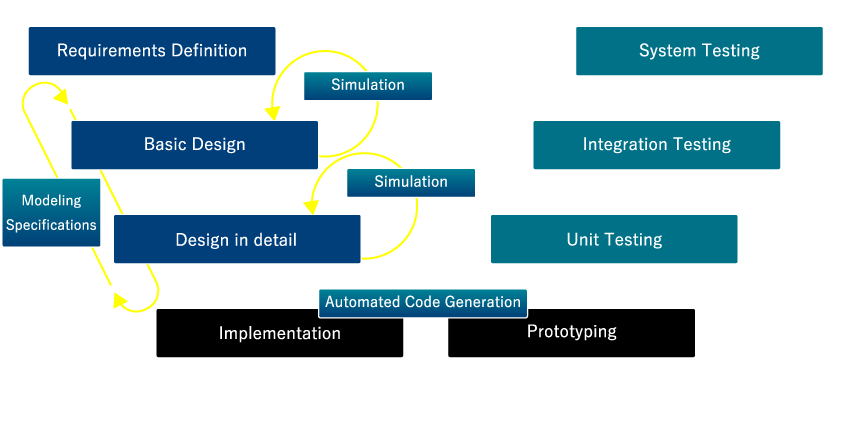The Potential of Model-Based Deveopment (MBD) and Key Points for Its Introduction
2024.07.26
- MBD
What is the Importance of Model-Based Development (MBD)?
Recently, the keyword 'CASE'—which stands for Connected, Autonomous, Shared & Services, and Electric—has been gaining prominence in the automotive industry. Particularly, the development of automotive control systems is reaching a significant turning point in realizing these technologies. Leading this revolution is Model-Based Development (MBD).
What is Model-Based Development (MBD)?
Differences between traditional development methods and MBD
Compared to the traditional approach of 'creating actual parts, assembling them, and testing the prototype,' Model-Based Development (MBD) uses 'virtual models' to represent 'reality.'
Specifically, by using tools such as MATLAB/Simulink to repeatedly simulate the behavior of prototypes created in a virtual space, MBD achieves efficient development.
Specifically, by using tools such as MATLAB/Simulink to repeatedly simulate the behavior of prototypes created in a virtual space, MBD achieves efficient development.
Benefits of introducing MBD
What benefits can be expected from 'modeling' in control system development?
In traditional methods, various departments work on the design, implementation, and testing of different parts of a system prototype using their own personnel and budget. Afterward, these parts are assembled into a prototype, which is then evaluated through integration tests and system tests. Each department takes the evaluation results back and makes improvements for the next prototype. Achieving a fully functional system on the first attempt is extremely challenging with this method, and it typically requires multiple iterations to improve the prototype’s performance.
Modeling enables the following outcomes:
* The 'model' created with tools like MATLAB/Simulink is often called a 'Moving Specifications' because it represents complex calculations and processes in a Block Diagram, making it highly readable.
As shown in the diagram below, with traditional methods, overall evaluation is not possible until the integration testing stage. If problems are found during the evaluation, the results are sent back to the design phase for further prototyping. Even if the integration testing is successfully passed, any issues discovered during system testing require returning to the design phase with larger scale improvements. The larger the system, the greater the impact on time and cost.
In traditional methods, various departments work on the design, implementation, and testing of different parts of a system prototype using their own personnel and budget. Afterward, these parts are assembled into a prototype, which is then evaluated through integration tests and system tests. Each department takes the evaluation results back and makes improvements for the next prototype. Achieving a fully functional system on the first attempt is extremely challenging with this method, and it typically requires multiple iterations to improve the prototype’s performance.
Modeling enables the following outcomes:
- Centralized management of the entire process allows for efficient information sharing among all developers and departments.
- Simulation of the entire system reduces the number of prototypes needed, thereby cutting down on time and costs.
- Automatic generation of software and hardware code from the model reduces the potential for human error.
* The 'model' created with tools like MATLAB/Simulink is often called a 'Moving Specifications' because it represents complex calculations and processes in a Block Diagram, making it highly readable.
As shown in the diagram below, with traditional methods, overall evaluation is not possible until the integration testing stage. If problems are found during the evaluation, the results are sent back to the design phase for further prototyping. Even if the integration testing is successfully passed, any issues discovered during system testing require returning to the design phase with larger scale improvements. The larger the system, the greater the impact on time and cost.
Traditional V-type Development Model

With 'modeling,' as shown in the diagram below, evaluation through simulation becomes possible from the early stages of design. As the design of each part progresses, the accuracy of the evaluation improves, allowing the system to reach completion with fewer prototypes.
V-type Development Model After Implementing MBD

Issues and handling when introducing MBD
Despite the numerous benefits of Model-Based Development (MBD), the volume of the design process may increase until its operation becomes fully established. Therefore, it is essential to consider the impact of introduction in advance and to approach Model-Based Development (MBD) across the entire design department.
- Allocate personnel to transition to a front-loading approach, where the burden is placed on the early stages of design in anticipation of V-type Developing Model testing.
- Deploy personnel with expertise in modeling throughout all stages of the process.
- Establish model management rules (such as interface specifications and version control) between each stage of the process.
- As needed, convert 'past assets' (such as existing specifications and source code) into models.
- Since implementing MBD across all stages from the start is challenging, it is recommended to adopt it partially or incrementally.
SANEI HYTECHS' Initiatives
SANEI HYTECHS is a pioneer in the industry to introduce Model-Based Development (MBD) and research and development. We continue to address various customer needs through innovative proposals utilizing Model-Based Development (MBD) and by nurturing MBD professionals through its in-house training curriculum.
Research and Development of MBD and Development Achievements / Case
![[Image]SANEI HYTECHS](/en/shared/img/logo_w.png)